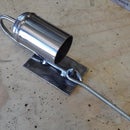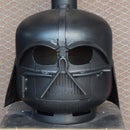Introduction: Portuguese Style Dory - REMIX
Hello Instructablers,
It is with much appreciation to rook999 that I create this remix of his awesome i'ble "Construction of Two Portuguese Style Dories".
Credit also goes to the designer of this boat Hannu Vartiala, who generously shares his designs on line here.
Without rook999 and Hunnu Vartiala's work, I would not have thought I had a boat in me. So, thank you both.
This project only took a few relaxing days to complete, and has been one of the most rewarding I've done. I hope you like my instructable.
Step 1: Getting Started
This is a very simple vessel and very economical.
Heres what I used:
- Two sheets of 7mm exterior plywood.Or better still marine ply.
- Scrap timber planks, weatherboards, etc. Whatever I could find.
- Some good quality glue.
- Small screws.
- Woven fibreglass strips. 50mm wide. About 6m of it.
- Chopped strand fibreglass mat. About a square metre in all.
- Resin for fibreglassing.
- Paint.
- Tools. Jigsaw, hand saw, drill, planer, screwdriver, scissors, fibreglass roller...
- Personal safety gear.
- And very importantly a link to Hannu's design page: http://koti.kapsi.fi/hvartial/dinghy1/simboii.htm
The first thing to do is mark out and cut your plywood according to Hannu's design. All the lines are straight, so this is a very simple process.
The next step is to join the two sides at the bow. A 50x50mm square timber is perfect for the joint as the angle is 90 degrees. Use glue and screws to fasten.
Prepare the two temporary cross members according to Hannu's plan, and mark on the sides where they will be positioned.
I used a loop of rope around the ends of the side and twisted "Spanish windlass" style to carefully pull the curves into the sides. See my pictures to see how you can use some wire to stop the rope from slipping. As the sides come together fasten the temporary cross members using some small screws.
When the sides are pulled in to the right position fasten the transom using blocks of timber similar to the bow. The angles won't be 90 degrees so you could plane the blocks to suit.
Step 2: The Bottom of the Boat
Now you have a nice boat shape, but no bottom.
Flip the boat over and plonk the slightly over-size bottom piece into position. Weigh it down with planks and something heavy. Then fasten it with small screws.
Trim around the bottom so it is neatly flush with the sides. You could use a router, but as I don't own one I used a jigsaw and finished it with a planer.
Step 3: Fibreglass the Seams
I used woven fibreglass cloth to securely join all the seams. Inside and out.
First cut the cloth strips to the required lengths and have them ready to use.
Only do a small amount at a time. The resin can harden quite quickly.
Mix the resin according to the instructions on the pack.
Paint resin onto the seams and place the strips of cloth over.
Paint more resin over the cloth and roll it in using a fibreglasser's rolling tool.
When all the outside seams are done and cured, flip the boat over again and do the insides.
Step 4: Add the Internal Bits and Pieces
Follow Hannu's instructions to make up the breast hook and seat support frame. My blocks supporting the transom meant I didn't need the quarter knees that Hannu uses.
For the gunwales I bought some 20x30mm hardwood. Carefully checking each piece to make sure there were no knots or ugly grain. I soaked some old towels with water and wrapped the timber in them and left it in the hot sun. I then used a hair dryer to make the curves. Fasten them to the boat using glue and screws. The system worked well and I the gunwales didn't break as I thought they would.
I chose to build a small seat in the stern for little children. And I used Hunnu's design of a longitudinal rowing seat. See the pictures.
I then installed blocks to support the rowlocks.
Step 5: Paint
The most expensive part of this build was the paint. I used marine paint. Beautiful glossy red for the hull and white for the trim. I just used linseed oil for the interior. The theory is that the oil finish allows water to escape from the timber. Apparently it's impossible to exclude all water so it's best to leave it a way out.
I spent a few hours making some very ordinary rowlocks from scrap stainless steel, bolts and rubber hose. I did get them working OK and then discovered that real rowlocks only cost about three bucks each. I'll go with the bought ones next time.
I also couldn't resist making a traditional looking anchor out of some rebar. That was another fun build. As were the oars. But they are another Instructable.
Step 6: Conclusion
This was a highly satisfying project. The little boat looks great on the water and it rows really nicely. I thoroughly recommend anyone give it a go.
Thanks again to Rook999 and Hannu for the instructions and the inspiration.
I hope you have enjoyed this Instructable. Please feel free to comment or ask any questions.
Step 7: Project Update - a Major Refit Including Rigging for Wind Power
One day I was doing a job on a farm and I noticed a once loved Mirror dinghy slowly rotting away under a tree. I asked the owner what his plans for it were and it turned out that he had built the boat himself and was loath to throw it away, but it was clearly beyond restoration. When I suggested that I would be able to put at least part of it to good use he agreed to give it to me.
I loaded to poor thing onto a trailer and dragged it home. I ripped all the useable hardware off it and used what I could to rig my little dory for sail.
Sea trials will commence as soon as time and weather permits. What could possibly go wrong?

Third Prize in the
Remix Contest

Participated in the
Formlabs Contest













